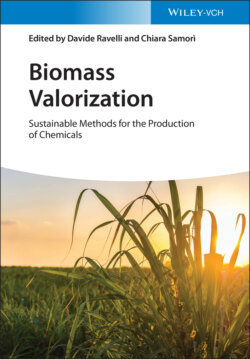Читать книгу Biomass Valorization - Группа авторов - Страница 10
Preface
ОглавлениеIt is nowadays apparent that the chemistry of the future will involve the exploitation of biomass‐based renewable materials, the currently available stock of fossil resources being doomed to exhaustion. This transition may indeed bring about several benefits because having recourse to renewable resources should limit the impact human activities are having on climate change.
Currently, the use of biomass by mankind is limited to addressing a few specific needs, notably fulfilling the feed demand and supplementing energy production in addition to the fossil fuel portfolio. The impact of these activities on the net primary production (NPP) of terrestrial and marine biomass can be accounted for by considering the human appropriation of net primary production (HANPP) parameter, which corresponds to all the human alterations of photosynthetic production in the ecosystems. This constant HANPP represents a significant fraction of the NPP and has a huge impact on ecosystems because it reduces the amount of energy available to other species, influences biodiversity, and alters water, energy, and carbon flows within food webs, also modifying the distribution of resources. In the prospected future scenario of a massive use in industry, biomass will at some point become a scarce resource, and its utilization should be considered wisely, accordingly. In particular, the entire substitution of fossil fuels with biomass for energy production purposes is unrealistic because of the huge amount of biomass that should be devoted at this end. Furthermore, one may argue if this kind of application is the best use possible of biomass, fully exploiting its characteristics in terms of chemical composition.
Through history, a variety of biomass constituents have been employed in the preparation of valuable drugs, flavors, and fragrances, or to provide, especially in the second half of the nineteenth century, commodity materials such as cellulose esters (nitrate and acetate) and oxidized linseed oil (linoleum). Indeed, there exist different options of using biomass to produce chemicals. Nowadays, let apart the use of wood in the paper industry, bio‐based surfactants, lubricants, coatings/dyes, additives for plastics and solvents (mostly based on vegetable oils/animal fats, sugar, or starch) are the most important applications of biomass in chemistry. As for future applications, the question is still open; however, it can be anticipated that the use of biomass for chemicals production is a much more sustainable option than having recourse to it for energetic purposes. Furthermore, in addition to merely duplicating existing products deriving from fossil resources, the chemistry of biomass opens the opportunity to develop a new portfolio of products, having no equivalence among those presently manufactured by classical synthetic routes from hydrocarbons. A subsidiary advantage is that the development of bioproducts requires fewer legislative constraints.
Accordingly, there is an increasing interest in developing suitable techniques to tackle the valorization of biomass to produce chemicals and this area is expected to further expand in the future. Along the same line, bio‐based waste materials, to be included in a circular economy perspective, can likewise contribute significantly. Independently from the actual biomass employed, this is a challenging area because inhomogeneous materials with variable composition must be processed with tailored technologies. The book “Biomass Valorization: Sustainable Methods for the Production of Chemicals” is intended to present the state of the art of the different strategies available nowadays to convert biomass into useful building blocks/commodity chemicals.
Each chapter features an introductory section, detailing the core details of the described technology and showcasing the typical chemical pathways that can be activated by having recourse to it. Next, peculiar advantages and limitations of the described strategy in the processing of biomass are described. Finally, relevant examples from the recent literature are reported, with attention to the organic chemistry perspective, also indicating how the different approaches can modify and valorize the native functionalities present in the starting biomass.
After an introductory section (Chapter 1), intended to set the stage and describe how biomass can contribute to the production of chemicals, the rest of the book has been organized according to the diverse approaches that can be exploited, also highlighting the potential, challenges, and innovative solutions associated with them. Biomass valorization processes have been explored using catalytic routes, including acid catalysis (Chapter 2), base catalysis (Chapter 3), metal catalysis (Chapter 4), and biocatalysis (Chapter 5). Various thermal strategies that can be applied for the valorization of biomass involve pyrolysis (Chapter 6) and thermochemical–biological hybrid processes (Chapter 7). Different advanced/unconventional strategies have also shown great promise, such as those involving electrochemical (Chapter 8) and photochemical (Chapter 9) means, microwave treatment (Chapter 10), ultrasound‐assisted approaches (Chapter 11), and mechanochemical approaches (Chapter 12). As a final contribution, biomass processing from an industrial perspective is assessed (Chapter 13).
There is no doubt that in the future, the production of chemicals will be based on the exploitation of biomass and the time has come to find the best methods to address this challenge and put it into practice.
November 2020
Chiara Samorì, University of Bologna, Italy
Davide Ravelli, University of Pavia, Italy
